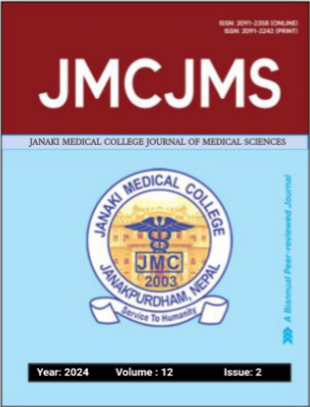Antibiogram and Salmonella typhi detection in suspected patients using advanced PCR technique, serology, and conventional blood culture
DOI:
https://doi.org/10.3126/jmcjms.v12i02.68326Keywords:
Antimicrobial susceptibility test, hila, MDR, PCR, WidalAbstract
Background & Objectives: Salmonella enterica serovar Typhi is a diverse gram-negative bacillus that causes life-threatening invasive bloodstream infection and remains a public health burden in developing countries. The antimicrobial resistance in Salmonella typhi has led to widespread multidrug resistance strains making complication in the treatment and demanding alternative therapies. Various diagnostics test such as blood culture, serological assay, and molecular assay are available. PCR is a newer gold standard method, but blood culture is still considered a definitive diagnosis of typhoid fever.
Materials and Methods: A cross-sectional study was conducted. Venous blood was collected, and a widal test was performed to detect antibodies against O and H antigens in serum. Blood culture, isolation, and identification were performed using the standard techniques. The antibiogram of isolates was performed by the Kirby Bauer method. Amplification of the hilA gene through PCR was used for the molecular diagnosis.
Results: Out of 141 suspected typhoid patients, 78 were males, and 63 were females. PCR detected maximum positivity rate (70%) followed by Widal test (43.26%) and blood culture (16.25%). PCR positive cases were highly prevalent in the male in less than 15 years of age group (14.8%), followed by 15-30 (12.7%) and 30-45 (9.1%). The isolated organism was found to be 100% sensitive to most antibiotics studied, except ofloxacin, which showed 71.4% sensitivity. In contrast, all the isolates were 100% resistant to nalidixic acid. None of the isolates showed multi-drug resistance.
Conclusion: PCR is a sensitive, rapid, and better alternative than conventional methods that can be used in clinical diagnosis for early detection of the Salmonella typhi.
Downloads
Downloads
Published
How to Cite
Issue
Section
License
© JMCJMS, JMC, Janakpur, Nepal




